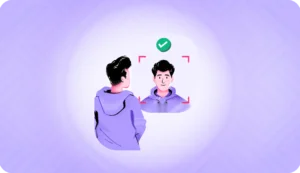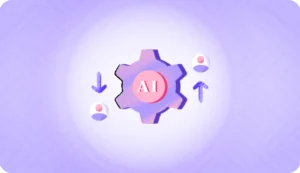The advancement of AI Face Recognition technology is reshaping the landscape of digital security, biometric verification and identity verification. Its success hinges on one crucial aspect – accuracy.
This blog post aims to demystify the methods and best practices to enhance the precision of AI Face Recognition. We will delve into the challenges and solutions, including optimizing image quality, refining algorithms, and ensuring diversity in datasets.
As we explore ways to ensure the highest accuracy of face recognition, we’ll also address the ethical implications of deploying this technology, such as avoiding bias and maintaining data privacy.
What is AI Face Recognition Technology?
AI Face Recognition Technology is an advanced form of biometrics that uses artificial intelligence to identify or verify a person’s identity using their facial features.
This technology operates by analyzing specific characteristics of a person’s face, such as the shape of their facial features, distances between different facial points, and unique patterns.
How It Functions:
- Capture: It begins by capturing a facial image or video.
- Analysis: The facial recognition software analyzes the facial features, focusing on key aspects like the distance between the eyes, nose shape, and jawline contours.
- Mapping: These features are then mapped to create a digital representation of the face, often referred to as a facial signature.
- Comparison and Verification: This facial signature is compared against a database of known faces for identification purposes or used to verify the identity of an individual against a pre-existing record.
Read more: How does facial recognition work?
Primary Uses:
- Security: Widely used in security systems for identifying or tracking individuals.
- Personal Authentication: Commonly utilized in smartphones and other devices for user authentication.
- Retail and Marketing: Employed in personalized advertising and customer service.
- Healthcare: Used for patient identification and access control in sensitive areas.
How is Accuracy in AI Face Recognition Determined?
The accuracy of AI Face Recognition Technology is primarily determined through specialized testing and evaluation methods. These methods assess how well the technology can identify or verify individuals based on their facial features.
Evaluation Metrics
- Verification vs Identification: There are two primary modes of assessment – verification and identification. Verification (1:1 matching) checks if two images are of the same person, while identification (1:N or 1:many matching) involves comparing an unknown face against a database of known faces to establish identity. Identification is generally more complex and less accurate due to challenges in capturing consistent, high-quality images in uncontrolled environments.
- Standard Assessments: One of the standard assessments used is the National Institute of Standards and Technology’s (NIST) Facial Recognition Vendor Test (FRVT). This test evaluates the performance of facial recognition algorithms under various conditions. In ideal settings, top verification algorithms have reached accuracy scores as high as 99.97%, comparable to the best iris scanners.
- Effect of External Factors: Real-world conditions, however, often lead to lower accuracy rates. Factors like inconsistent lighting, angles, and obstructions can significantly affect performance. For instance, the error rate for a leading algorithm increased from 0.1% with high-quality mugshots to 9.3% with images captured in less controlled environments.
- Confidence Scores: Algorithms are also adjusted to avoid false positives, with many systems using confidence thresholds to only report back matches that meet a certain level of certainty. This, however, can lead to higher miss rates as it may discount correct but low-confidence matches.
Factors Affecting the Accuracy of AI Face Recognition
Several intrinsic and extrinsic factors can influence the performance of AI Face Recognition systems:
- Aging: Changes in facial features over time, such as wrinkles or alterations in face shape, can impact recognition accuracy.
- Facial Expression: Variations in facial expressions can confuse algorithms, as they change the geometry of the face.
- Plastic Surgery: Surgical changes to facial features pose a challenge to recognition systems, which may struggle to identify individuals post-surgery.
- Occlusion: Obstructions like masks, sunglasses, or even facial hair can deteriorate algorithm performance.
- Low Resolution: Images of low quality, often from surveillance cameras, negatively impact recognition rates.
- Noise: Digital noise in images needs pre-handling for algorithms to function effectively.
- Illumination: Variations in lighting can affect how algorithms perceive facial features.
- Pose Variation: Non-frontal views of faces can reduce accuracy, as most databases store frontal features.
The Importance of Continually Improving the Accuracy of AI Face Recognition
The continuous improvement in the accuracy of AI Face Recognition technology is crucial due to the evolving challenges it faces, such as adapting to varying external conditions and the sophistication of spoofing techniques. As facial recognition systems improve, the error rate has dramatically decreased, but the technology still faces challenges in real-world settings.
For instance, factors like lighting, positioning, and obstructions can significantly impact accuracy. Additionally, the face detection technology’s performance varies considerably across vendors, with some achieving high accuracy while others struggle.
The importance of accuracy in facial recognition technology also extends beyond simple identification; it involves ensuring reliability in diverse applications and minimizing risks of misidentification.
Improvements in this technology have led to increased deployment, emphasizing the need for proper governance and oversight. This is particularly important given the wide range of accuracy among different systems and their sensitivity to external factors.
Continual advancements in facial detection and recognition are necessary to address these challenges and enhance the technology’s reliability and effectiveness in real-world applications. This involves not only improving the algorithms but also ensuring they are trained on diverse and comprehensive datasets.
How to Ensure High Accuracy in AI Face Recognition
Ensuring high accuracy in AI Face Recognition involves a multifaceted approach, addressing various aspects of facial recognition work from data quality to algorithm optimization and beyond. Let’s explore these critical steps:
1. Using high-quality data:
- Diverse Representation: Utilizing a diverse range of facial images in training datasets is essential. This includes varying ethnicities, ages, genders, and facial expressions to create a robust model that can accurately recognize a wide spectrum of faces.
- Addressing Data Bias: It’s crucial to identify and correct biases in datasets. Bias can occur due to overrepresentation or underrepresentation of certain demographic groups, leading to unfair or inaccurate outcomes.
- Data Augmentation: Implementing techniques like data augmentation can enhance the diversity and size of training datasets. This involves altering images (e.g., lighting changes, rotations) to create additional training examples, thus helping the model generalize better to new data.
Read more: How to Mitigate Facial Recognition Bias
2. Optimizing algorithms:
- Fine-tuning for Use Cases: Tailoring algorithms for specific applications ensures that they perform optimally in different environments, whether it’s for mobile authentication or surveillance.
- Exploring New Architectures: Investigating cutting-edge deep learning architectures and techniques can lead to significant improvements in face recognition performance.
- Ensemble Methods: Leveraging a combination of different models or techniques can enhance overall accuracy and robustness, compensating for the weaknesses of individual models.
3. Implementing effective pre-processing and feature extraction:
- Pre-processing Techniques: Implementing techniques like noise reduction and image normalization helps in preparing images for more effective analysis.
- Feature Extraction Methods: Choosing the right methods to capture relevant facial features is critical. This might include techniques like edge detection or deep learning-based feature extraction.
- 3D Reconstruction: Utilizing 3D facial reconstruction can significantly improve recognition accuracy, especially in challenging conditions like varying poses or lighting.
4. Employing robust liveness detection:
- Preventing Spoofing Attacks: Robust liveness detection methods are essential to prevent spoofing attacks, where photos, videos, or masks are used to fool the system.
- Combining Techniques: Using a mix of passive and active liveness detection methods, such as analyzing texture, movement, and depth information, enhances security.
- Regular Updates: Continuously updating liveness detection models is crucial to keep up with evolving spoofing techniques.
Read more: Liveness Check: A Comprehensive Method Comparison and Benchmarks
5. Conducting rigorous model evaluation and calibration:
- Thorough Testing: Regular and rigorous testing of face recognition models across various scenarios is crucial for assessing their real-world effectiveness.
- Calibration Techniques: Employing calibration methods can help mitigate biases in the algorithms, ensuring fairness and accuracy across different demographic groups.
- Ongoing Optimization: Continuous monitoring and refinement of model performance are necessary to maintain high accuracy over time.
6. Choosing the right AI face recognition software:
- Feature Checklist: When selecting AI face recognition software, it’s imperative to consider a comprehensive set of features that align with specific needs and use cases.
Related read: Top 10 Face Recognition Software (Feature Checklist Included)
Conclusion
Throughout this article, we’ve highlighted the pivotal aspects of enhancing facial recognition technology, focusing on the importance of high-quality data, algorithm optimization, effective pre-processing, robust liveness detection, and thorough model evaluation. These elements are crucial for ensuring accuracy, fairness, and security in facial recognition systems.
HyperVerge, with its NIST and iBeta certified facial recognition solutions, stands at the forefront of this technology. Our facial recognition systems offer unparalleled accuracy and reliability.
Experience the cutting-edge capabilities of HyperVerge’s AI-powered Facial Recognition software. Ready to take the leap? Sign up now to explore how we can elevate your user onboarding and identity verification workflows.
FAQs
Q. What is the difference between face detection and face recognition?
Face detection and face recognition, while interconnected, serve different purposes. Face detection is the process of identifying the presence and location of faces in a digital image or video. It simply detects faces without identifying who the faces belong to. In contrast, face recognition goes a step further by not only detecting faces but also identifying or verifying them against a known database of faces. This process involves comparing the detected face with pre-stored face data to recognize the individual’s identity.
Q. How accurate is AI face recognition?
AI face recognition has achieved significant levels of accuracy, especially in controlled environments. Modern AI-powered face recognition systems, like those developed by HyperVerge, can achieve accuracy rates of over 95%, with some systems even reaching 99.97% under ideal conditions. However, the accuracy can vary based on several factors, including the quality of the input data, lighting conditions, and the algorithms used.
Q. How has accuracy in AI face recognition improved?
The accuracy of AI face recognition has improved dramatically over the years due to advancements in deep learning, increased computational power, and more sophisticated algorithms. Improved training techniques, better quality datasets, and enhanced pre-processing methods have also contributed to this progress. Continuous research and development in this field are further pushing the boundaries of accuracy.
Q. Is face recognition accurate for ID verification?
Yes, face recognition has become increasingly accurate for ID verification purposes. With advancements in AI and machine learning, face recognition technology can now accurately match a person’s live facial features with those in an ID document, such as a passport or driver’s license.
This technology is particularly useful in identity verification processes in various sectors, including banking, security, and the gig economy. For more information on how face recognition is utilized for ID verification, check out how facial recognition is used for identity verification use cases.





